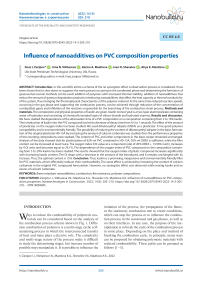Influence of nanoadditives on PVC composition properties
Автор: Zaripov I.I., Vikhareva I.N., Mazitova K.A., Shevelev I.N., Mazitova A.K.
Журнал: Nanotechnologies in Construction: A Scientific Internet-Journal @nanobuild-en
Рубрика: The results of the specialists’ and scientists’ researches
Статья в выпуске: 3 Vol.14, 2022 года.
Бесплатный доступ
Introduction. In this scientific article a scheme of the no synergistic effect is observedion process is considered. It has been shown that to slow down or suppress the main process occurring in the condensed phase and determining the formation of gaseous fuel several methods can be used: addition of polymers with increased thermal stability; addition of nanoadditives that reduce the amount of gaseous degradation products; introducing nanoadditives that affect the heat capacity or thermal conductivity of the system, thus changing the thermophysical characteristics of the polymer material. At the same time reduced reaction speeds, occurring in the gas phase and supporting the combustion process, can be achieved through reduction of the concentration of combustible gases and inhibition of the reactions responsible for the branching of the combustion chain process. Methods and materials. The composition and physical properties of kaolin are given. Kaolin monocrystal is a two-layer aluminosilicate containing water of hydration and consisting of chemically bonded layers of silicon dioxide and hydrated alumina. Results and discussion. We have studied the dependence of the attenuation time of a PVC composition on a composition containing from 3 to 10% kaolin. The introduction of kaolin into the PVC compound has led to decrease of decay time from 4.5 to 1 seconds. The effect of the amount of plasticizer on the oxygen index has been studied. We used dibutoxyethyl adipate (DBEA) as a plasticizer. It has good polymer compatibility and is environmentally friendly. The possibility of reducing the content of dibutoxyethyl adipate in the basic formulation of the original plasticate I40-13A by increasing the amount of calcium carbonate was studied, then the performance properties of the resulting compositions were studied. The content of PVC and other components in the basic recipe remained unchanged. Analysis of the data showed that for plasticization of 62% wt PVC contained in I40-13A, 20% wt DBEA is sufficient, while the filler content can be increased at least twice. The oxygen index (OI) value at a component ratio of 20% DBEA + 13.56% CaCO3 increases by 4 OI units and becomes equal to 29.1%. The dependence of the oxygen index of PVC compound on the composition containing from 5 to 20% kaolin has been studied. The results showed that the oxygen index of plastic compound increases significantly with increasing kaolin content. The OI drops with a decrease in the amount of the introduced, and it remains unchanged with its increase. Thus, the optimal content is 15%. Conclusion. Thus, kaolin is a promising, inexpensive and environmentally friendly filler for PVC materials, which effectively reduces their combustibility. The same effect is achieved by increasing the content of calcium carbonate in the original PVC compound formulation. However, no synergistic effect was observed while mixing kaolin and an excess of calcium carbonate.
Flame retardant nanoadditives, combustion, fire resistance, polymer compositions
Короткий адрес: https://sciup.org/142232051
IDR: 142232051 | DOI: 10.15828/2075-8545-2022-14-3-205-210
Список литературы Influence of nanoadditives on PVC composition properties
- Aseeva R.M., Zaikov G.E. Reducing the combustibility of polymeric materials. Moscow: Knowledge; 1981. 61 p.
- Weil E., Levchik S. Flame retardants for plastics and textiles. Practical use. Munich: Hanser Publishing House; 2009.
- Glikshtern M. V. Fire Retardants. Polymer Materials. 2003; 3: 22–23; 4: 15–18.
- Khalturinsky N.A., Berlin A.A., Popova T.V. Combustion of polymers and mechanisms of action of fire retardants. Uspekhi khimii. 1984; 53(2): 21.
- Kopylov, V.V. Polymeric materials with reduced flammability. Moscow: Chemistry; 1986. 224 p.
- Gul V.E., Kuleznev V.N. Structure and mechanical properties of polymers. Moscow: Ed. Labyrinth; 1994. 367 p.
- Aseeva R.M., Zaikov G.E. Combustion of polymeric materials. Moscow: Nauka; 1981. 280 p.
- Baratov A.N., Andrianov R.A., Korolchenko A.Ya., Mikhailov D.S., Ushkov V.A., Filin L.G. Fire hazard of building materials. Moscow: Stroyizdat; 1988. 380 p.
- Kodolov V.I. Combustibility and fire resistance of polymeric materials. Moscow: Chemistry; 1976. 160 p.
- Kodolov V.I. Flame retardants of polymeric materials. Moscow: Chemistry; 1980. 274 p.
- Bulakh A.G. General mineralogy. St. Petersburg: Publishing House of St. Petersburg. university; 2002. 356 p.
- Belov N.V. Essays on structural mineralogy. M.: Nedra; 1976. 344 p.
- Katz S., Milevsky D. Fillers for polymer composite materials. Moscow: Chemistry; 1981. 736 p.
- Plotnikova G.V., Egorov A.N., Khaliullin A.K., Gusarova N.K., Shaikhutdinova S.I. Influence of organophosphorus additives and mineral fillers on the combustibility of plastisols. Fire and explosion safety. 2002; 11(5): 24–27.
- Tutorsky I.A., Pokidko B.V. Elastomeric nanocomposites with layered silicates. Properties of nanocomposites. Rubber and rubber. 2004; 6: 33.
- Lanina T.F., Timoshenko V.B. Application of thermal shock-modified phosphogypsum in rubber mixtures filled with light mineral fillers. Rubber and rubber. 2003; 4: 21–22.
- Arkhireev V.P., Gotlib E.M., Ibragimov M.A., Naumov S.V. Nanocomposites based on siloxane rubbers and layered silicates. Bulletin of the Kazan Technological University. 2010; 11: 514–518.
- Vindizheva A.S., Sapaev Kh.Kh., Khashirova S.Yu., Musov I.V., Mikitaev A.K. Polyvinylchloride compound with increased fire resistance. Science-intensive technologies. 2012; 1: 27–30.
- Hiraschler М.М. Thermal decomposition (STA and DSC) of PVC compounds under variety of atmosphere and heating rates. Polymer Journal. 1985; 22(2): 153–170.
- Levchik S.V. Introduction to Flame Retardancy and Polymer Flammability. Flame Retardant Polymer Nanocomposites. 2006; 1–29.
- Shaklein A.A. et al. Two-step gas-phase reaction model for the combustion of polymeric fuel. Fuel. 2019; 255(115878).
- Snegirev A.Y. et al. Autocatalysis in thermal decomposition of polymers. Polymer degradation and stability. 2017; 137: 151–161.
- Edgeriey Р.С., Oldland S.R. HCL-bildung beim verbrennung von PVC. Kunststoffe. 1980; 70(4): 217–221.


